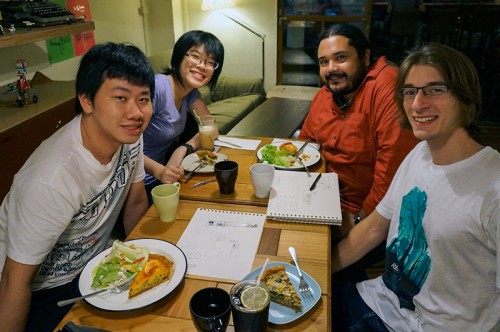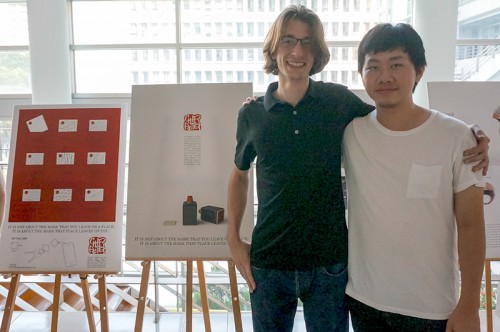
Sharing drawing techniques and opinions on design over dinner in Taiwan are (L to R) Jr Feng Kwan, Ying-Hsiu Chen, Raul-David Poblano and Russell Singer.
It was Friday at the end of week 12, summer 2013 term, and like most Art Center students I was busy. Unlike most students who were busy with drawings and artwork and projects, I was busy packing for a leap of faith. I would attempt to finish out my term from across the world in Taipei, Taiwan, as I participated in National Taiwan University of Science and Technology‘s (NTUST) International Summer Design Workshop. I finished packing, preoccupied with thoughts about school work and the unknowns of a distant place, when my phone buzzed. Cedric, my partner for two studios (and also a Taiwan native), had arrived to give me a lift to LAX. My classmate Raul-David would be joining me for the actual workshop, and so Cedric and I set off to pick him up. As we drove we discussed plans for our coursework, and he offered helpful tips about his home country; I realized I’d have to trust a lot of people this week, especially Cedric.
The 13-hour flight was filled with CAD, PowerPoint and restless sleep. After landing, a cab ride, check-in and a shower, it was near midnight Saturday. Yet our Pacific time zone stomachs demanded lunch. So with a map from the front desk, we set out to find one of the night markets Taipei is famous for. I had barely eaten my first meal in Taiwan and I was amazed at the life and interest to be found here. As our classmates in Pasadena were waking up, we turned in for some rest before our big week. Sunday morning Raul-David and I would meet our partners, Ying-Hsiu and Kwan, for the first time.
The workshop officially kicked off with a dinner and lectures by distinguished guests. I was left with a clear impression that design holds a place of reverence in Taiwan. Even the Minister of the Economy spoke about the importance of design to the well-being of people and the economy.
The following week involved cramming in two months’ worth of activity. The theme of the workshop was “Breaking Cultural Shock.” So we were encouraged to see as much of Taiwan’s culture as possible. And we did a pretty good job of it. Neither jet lag nor the dramatic humidity could slow us down. Every day was packed until our feet hurt. Then we would sit down for drinks. We made our way through the famous night markets, shopping districts, design studios, museums and landmarks.
In addition to the big-ticket sightseeing locations, we also got to see the daily life and a native perspective of Taipei from our workshop partners. Because the workshop’s focus was culture, every excursion offered a chance to inform and improve our design concept … and a great excuse to pop into every interesting doorway we saw. From the beautiful textures at the centuries-old temple to the organized chaos of the crowded streets to the characteristic graffiti on the walls of a basement ice cream shop — we were ambushed by inspiring cultural intrigue from all sides. It also bears mentioning that the NTUST campus was as sculptural and beautifully designed as the rest of Taipei. The furniture design classroom, full of the most iconic chairs from the highest echelons of design, would impress even the most experienced designer.
As the work rolled on, I began to really appreciate our teachers for the workshop, Jeremy Sun and Tim Ryan. Both were incredibly helpful and, as a unit, they comprised a perfect balance of personalities. Jeremy was thoughtful and his insightful critiques pushed our concept forward. Tim’s inimitable excitability and fast-paced conversation kept us positively motivated.
We were challenged to reimagine and redesign a cultural artifact from one or both of our cultures. And after a few days of exploration and discussion, Kwan and I decided to combine two parts of our cultures and imagine something totally new. The inspiration came from the traditional Chinese “chop,” or name stamp, used as a unique personal mark on official matters, combined with the colorful graffiti tags you’re likely to see around Los Angeles. We ended with a concept that felt serendipitous, though it was no doubt the result of our shared experience.
By the end of the week, culture shock was the furthest thing from my mind. After just seven days, I felt completely at home with my new friends. The kind of friendships that formed during that week can only happen when people have a real opportunity to share an immersive learning experience.
When we first arrived, I had feared the language barrier. Yet as I witnessed speakers from around the world risk embarrassment and frustration to converse in my native tongue, I quickly realized how lucky I was to be the English speaker in a foreign country. Some thoughts would need to be translated through multiple languages before reaching the final recipient, so I felt an extra responsibility to completely focus on understanding others, and on helping others understand. Perhaps three days in, I realized this language constraint put a heightened value to our conversations. There are many ways that Art Center teaches how important it is for designers to be great connectors and communicators, and this lesson was strongly reinforced by my time at NTUST. Working in such an environment highlighted the many different ways we communicate, and how important patience is in the process.
Sooner than I could have imagined at the start, the final day was upon us. Just like any final back home, we were up all night frantically going over our presentation and refining our concept. The presentation itself was a bit stressful of course, presenting that much work to a large audience with distinguished judges. But I couldn’t help but look back on the entirety of the experience and feel overwhelmed in a way that made the stress of the presentation seem novel and inconsequential. While we awaited the judges deliberation everyone was abuzz. With so many ingenious concepts and clever displays of prototyping there was no way of telling who would do best. Instead, we all just spoke of our equal levels of amazement at the work, and at the workshop itself.
Waiting patiently in our seats again, our workshop TA Tanya announced the results. Raul-David and Ying-Hsiu were awarded the 3rd place prize for their excellent project titled Gaggle; a board game to help speakers of different languages and levels communicate, by using clever constraints and personal interactions that make conversation the end goal. The judges were impressed with the quality of their design, the relevance to their experience in the workshop, and their ability to take a prototype into testing and revision in just one week. After the other finalists were announced, we were getting ready to head off to our closing day party, when Kwan and I were surprised to get called up to the front of the room. We were given the Creative Design Award for having such a unique and deeply thought-out concept, clearly derived from our experiences during the workshop.
Our project, Character, is an object that takes inspiration from both Taiwanese and American culture, and creates a new way of representing yourself. Inspired by a combination of the graffiti tags common in L.A. and the traditional name stamp used as a unique personal identifier in the East. Character allows you to “stamp” any object or texture, and creates keepsake “tags,” like 3-dimensional rubbings, which can be applied to the objects within your life. Over time, the objects you “tag” with Character grow into a collection that tells the story of who you are, and what places impacted you. It is not about the mark you leave on a place; it is about the mark that place leaves on you.
Our last night went by in a flash. Despite the exhaustion from the late night of work before, everyone buzzed with energy straight past the closing events and into the Taipei nightlife. As a big group we walked, stopping from time to time at interesting places, but mostly just enjoying the city and each others’ company. We recounted how much we learned from the workshop and what we learned about each others cultures, and joked about our first impressions and how they changed after working closely with each other. Although we spent the whole week together, the last night felt more like a reunion than a departure.
I awoke after what felt like a full night’s sleep to find the plane nearing arrival to LAX around 10pm on the Sunday before week 14. Returning to Art Center after such a distant, fast-paced week, was a surreal experience — it felt as though much more time had passed than did in reality. My classmates and studio were much the same, although it was clear nobody had wasted any time. This is Art Center, after all.
Russell Singer is a fourth-term student in the six-term Graduate Transportation Design program at Art Center. An industrial designer with a BFA from Carnegie Mellon University, Singer has experience in leading design workshops, product design and furniture design. His current focus is the relationship of human psychology to transportation and the democratization of transportation.
Art Center’s Graduate Transportation program prepares students to become creative agents of change who will lead the evolution of thinking in the automotive/vehicle industry and the broader field of transportation system providers and personal mobility.









